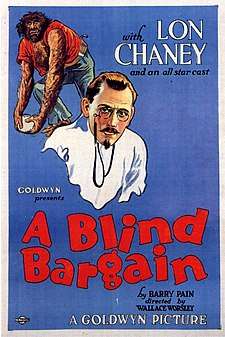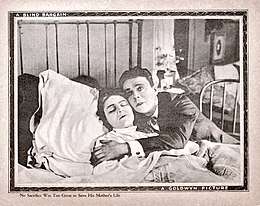A Blind Bargain
A Blind Bargain is a 1922 American silent horror film starring Lon Chaney and Raymond McKee, released through Goldwyn Pictures. The film was directed by Wallace Worsley and is based on Barry Pain's 1897 novel The Octave of Claudius.[1] The film, which features Wallace Beery in an unbilled cameo as an ape-man, is now considered lost.[2]
| A Blind Bargain | |
|---|---|
 Wallace Beery (background) and Lon Chaney, on the original, 1922 theatrical poster | |
| Directed by | Wallace Worsley |
| Produced by | Samuel Goldwyn |
| Written by | J.G. Hawks |
| Based on | The Octave of Claudius by Barry Pain |
| Starring | Lon Chaney Raymond McKee Jacqueline Logan Wallace Beery (uncredited) |
| Music by | J. Bercovitch (cue sheet) |
| Cinematography | Norbert Brodine |
| Edited by | Paul Bern |
| Distributed by | Goldwyn Pictures |
Release date |
|
Running time | 57 minutes |
| Country | United States |
| Language | Silent (English intertitles) |
Plot
The film is a contemporary (1920s, though the book was published in 1897) picture that takes place in New York City. The story involves a mad scientist who turns circumstances on a young man to do his bidding.
Robert Sandell (Raymond McKee), despondent over his bad luck as a writer and his mother's declining health, attacks and attempts to rob a theatergoer, Dr. Lamb (Lon Chaney), a sinister, fanatical physician living in the suburbs of New York. Lamb takes the boy to his home, learns his story, and agrees to perform an operation on Mrs. Sandell (Virginia True Boardman) on one consideration – that Robert shall, at the end of eight days, deliver himself to the doctor to do with as he will, for experimental purposes. Frantic with worry over his dying mother's condition, Robert agrees.
Mother and son take up their residence in the Lamb home, where Robert is closely watched, not only by the doctor, but by his wife (Fontaine La Rue) and a grotesque hunchback (Lon Chaney, in a dual role), whom Robert learns afterwards is the result of one of the doctor's experiments.
Dr. Lamb, anxious to keep his hold on Robert, not only gives him spending money, but assists him in having his book published through Wytcherly, head of a publishing company. Robert meets Wytcherly's daughter Angela (Jacqueline Logan) and promptly falls in love.
In the meantime, the days are slipping by to the time of the experiment. Robert has been warned by Mrs. Lamb and the hunchback that great danger threatens him. At dawn, they show him as a warning a mysterious underground vault in which is a complete operating room and a tunnel of cages in which are strange prisoners – previously failed experiments of Lamb's. In agony and fear, Robert goes to the physician and tries to buy himself out of the bargain, for his book has been published and he is now a successful writer. There is yet one day before the time limit is up, but the doctor, realizing his victim may try to escape, seizes him and straps him to the operating table. He is rescued by Mrs. Lamb, the hunchback releases a cage door, and the doctor is himself brought to a horrible end at the hands of an ape-man wrecked mentally by the doctor's experiments.
Finally freed from the terms of his "blind bargain", Robert returns to his home to learn that his writings have met with success and that Angela waits for him at the marriage ceremony.

Cast
- Lon Chaney as Dr. Arthur Lamb/The Hunchback
- Raymond McKee as Robert Sandell
- Virginia True Boardman as Mrs. Sandell
- Aggie Herring as Bessie
- Virginia Madison as Angela's Mother
- Fontaine La Rue as Mrs. Lamb
- Jacqueline Logan as Angela Marshall
- Wallace Beery as Beast man (uncredited)
Background and production
Based on Barry Pain's novel, The Octave of Claudius, A Blind Bargain tied together horrific elements for which Lon Chaney became so well known. His characterizations of both Dr. Lamb and the hunchback assistant showcased Chaney's talent for makeup. For the finale, the ape-man that is released upon Dr. Lamb was played by Wallace Beery, in a cameo performance.
Release and reception
The film was released December 3, 1922, at the Capitol Theater in New York, and met with a standing ovation the opening night of the film. Critical response for the film was good, most praising Lon Chaney's dual performance as the mad doctor and his servant as being the highlight of the picture.
Preservation and technical specifications

Today, the film is considered lost. The original negative was destroyed in 1931 by MGM several years after the takeover of Goldwyn Studios, and the last surviving print is believed to have perished in the same 1965 fire in Vault #7 that destroyed the last known prints of London After Midnight and other Chaney films.
The footage count in the film was 4,152 feet (1,266 m). The film was tinted and toned various colors, including blue tone/flesh tint, blue tint, night amber, straw amber, light lavender, green tint, and one sequence at a party was stencil colored using the Handschiegl Color Process, in multi-coloring bubbles that were made during a party.[3]
Influences
Three years after A Blind Bargain was released, Chaney's co-star, Ray McKee, appeared with Clara Bow in a film titled Free to Love. McKee's character is a criminal who is a hunchback. This character is the direct result of McKee's working with Chaney in A Blind Bargain and shows the Chaney influence on McKee. The character is a strange amalgam of Chaney's character in A Blind Bargain and of his real-life hunchback co-stars, John George, who was a Chaney regular in several films.
References
- White Munden, Kenneth, ed. (1997). The American Film Institute Catalog of Motion Pictures Produced in the United States: Feature Films, 1921-1930. University of California Press. p. 67. ISBN 0-520-20969-9.
- Soister, John T. (2012). American Silent Horror, Science Fiction and Fantasy Feature Films, 1913-1929. McFarland. p. 55. ISBN 0-786-48790-9.
- Original cutting continuity.
External links
| Wikimedia Commons has media related to A Blind Bargain. |
- A Blind Bargain on IMDb
- A Blind Bargain at AllMovie
- A Blind Bargain at silentera.com